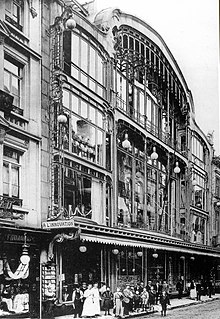L'Innovation department store fire
This article includes a list of references, related reading, or external links, but its sources remain unclear because it lacks inline citations. (February 2021) |
You can help expand this article with text translated from the corresponding article in French. Click [show] for important translation instructions.
|

The L'Innovation fire was a fire that took place at the À L'Innovation department store on the Rue Neuve/Nieuwstraat in central Brussels, Belgium, on 22 May 1967.[1] More than 150 firefighters were mobilised to fight it, 325 people were killed, 80 injured,[2] and the department store itself, the work of the Art Nouveau architect Victor Horta, was destroyed.
The L'Innovation fire remains the deadliest fire in Belgian history.[3]
The À L'Innovation store[edit]
The À L'Innovation department store was situated in central Brussels, on the fashionable Rue Neuve/Nieuwstraat, one of the main commercial streets in Belgium, located between the Place de la Monnaie/Muntplein and the Place Charles Rogier/Karel Rogierplein. It was housed in a purpose-built edifice constructed by the leading Art Nouveau architect Victor Horta in 1901.[4]
The store was subsequently radically altered over the years by integrating various neighbouring buildings to finally have five floors and a total of 24,000 m2 (260,000 sq ft) of shelving and 8,000 m2 (86,000 sq ft) of warehouses. By the time of the fire, in 1967, it was one of the main department stores in Belgium with daily takings of 30 million Belgian francs.[a][4] It was described as a "Temple of fashion, palace of housewives, luxury bazaar where you could [almost] find anything."[5]
Context and fire[edit]
An exhibit featuring American merchandise that began on 5 May and included blue jeans, barbecue equipment and paper dolls[6] had created outrage among a pro-China group called "Action for the Peace and Independence of Peoples." In the days leading up to the fire, picketing outside the store had taken place, while pamphlets promising greater conflict also circulated.
The blaze began in the five-storey structure at approximately 13:30 when more than 1,000 people were in the store. The store was built with an atrium in its centre, open to all floors and topped with a skylight, an architecture that behaved like a chimney giving a steady air draft to the store's wooden floors and walls. Cries of "fire!" caused panic, with virtually the entire store engulfed in just 10 minutes. No sprinkler system or other active fire-fighting system was present. Many shoppers rushed to windows, since the main stairway was enveloped in thick black smoke, while some jumped to their deaths before fire ladders arrived. Still others went to the roof and escaped via nearby buildings. Some employees, having become used to the exploding fireworks that protestors had set off, ignored pleas to leave the building until it was too late.
Investigation[edit]
The origin of the fire was a source of confusion, with store management first stating that the inferno began in the first-floor children's wear department. That was a contradiction of witnesses who had seen exploding butane canisters in the third floor camping department, as well as fourth floor problems[clarification needed] in the kitchen of the store's restaurant. In the aftermath of the fire, there was speculation that it might have been started by anti-American, Maoist protestors in the context of the Cold War and opposition movements against the United States involvement in the Vietnam War. Further controversy came about when one witness claimed to have heard one person shout after the fire began, "I am giving my life for Vietnam!".[7]
Aftermath[edit]

On 30 May, a funeral service for the victims, attended by Belgium's King Baudouin and Queen Fabiola, was held at the Basilica of the Sacred Heart. Other towns also held funeral masses. The fire marked the worst single-building fire worldwide since the 1961 Niteroi circus fire in Brazil, and was Belgium's greatest disaster since the August 1956 coal mine fire at the Bois du Cazier colliery at Marcinelle, in Hainaut.
Depiction in media[edit]
A Belgian art historian who lost his parents in the fire published a novel about the history of the event and included testimonies from survivors, called Happening. The Belgian director Jan Verheyen announced in 2021 that he was preparing to make a movie with the same title as the novel about the disaster.[8]
See also[edit]
References[edit]
Footnotes[edit]
Notes[edit]
- ^ Farnsworth, Clyde (23 May 1967). "22 Die in Brussels Fire at Store That Was Target of Red Protest; At Least 22 Are Killed in Brussels Department Store Fire No Positive Explanation". The New York Times. Retrieved 15 October 2021.
- ^ Houssiau 2002, p. 12.
- ^ Stéphany 2006.
- ^ a b Houssiau 2002, p. 20.
- ^ Houssiau 2002, p. 6.
- ^ Spignesi 2004.
- ^ Houssiau 2002, p. 209–210.
- ^ Bradshaw, Lisa (20 April 2021). "Movie in the works about deadliest fire in Belgian history". The Bulletin. Retrieved 15 October 2021.
Bibliography[edit]
- De Vriese, Geert; Van Laeken, Frank (2017). INferNO. De brand in de Innovation (in Dutch). Antwerp: Houtekiet. ISBN 978-908924-544-1.
- Houssiau, Bernard (2002). 22 mai 1967 - L'incendie de l'Innovation - 35 ans déjà ! (PDF) (in French). Waterloo: éditions Luc Pire. ISBN 2-87415-160-2.
- Evens, Siegfried (2017). De brand in de Innovation: een geschiedenis van de brand die België veranderde (in Dutch). Tielt: Witsand Uitgevers. ISBN 978-9-49201-153-4.
- Evens, Siegfried (2016). De brand in de Innovation: Het Inno-effect op de Belgische samenleving (PDF) (in Dutch). Leuven: Catholic University of Leuven thesis.
- Spignesi, Stephen (2004). Catastrophe! The 100 Greatest Disasters of All Time. New York: Kensington Publishing Corporation. ISBN 978-0-8065-2558-7.
- Stéphany, Pierre (2006). Les années 1960 en Belgique (in French). Brussels: Racine Lannoo. ISBN 978-2-87386-487-3.
External links[edit]
 Media related to L'Innovation Department Store fire at Wikimedia Commons
Media related to L'Innovation Department Store fire at Wikimedia Commons- Incendie de l’Innovation at SONUMA
- Incendie de l’Innovation photo collection

